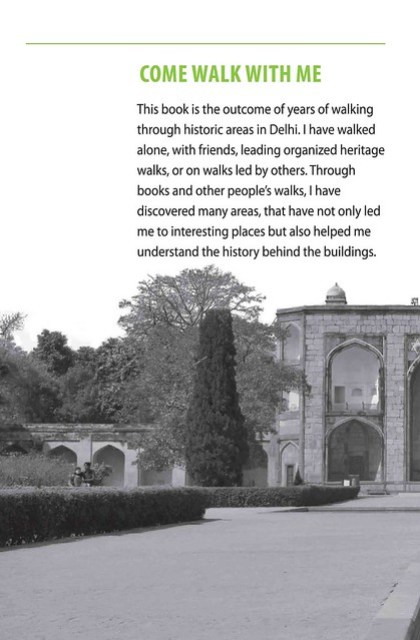
City Book – Delhi: 14 Historic Walks, Swapna Liddle

Walking with a guide.
[By Mayank Austen Soofi]
Considering the disrespect that car drivers give to pedestrians in Delhi, it is tough to believe that the Capital is meant for leisure walking.
But here are the secrets.
You can spend a day in Lutyens’ Delhi, walking past white colonial-era bungalows lined with trees. You can walk around the hilly slopes and monuments of the Mehrauli Archaeological complex. You can make endless circles around the Inner and Outer circles of Connaught Place shopping district, coming across landmarks that seem leftovers from another age. You can walk down central Delhi’s little-known but beautifully paved walk paths, such as the one that starts from Khan Market and goes all the way to the 14th century village Nizamuddin Basti. There are professionally conducted nature walks in parks and gardens.
And if you want to be certified as a true Delhiwalla, you might like to trudge through the crowded alleys of Old Delhi.
Published in late 2011, Delhi – 14 Historic Walks (Price: 495 Rs) is perhaps the first guide that focuses on exploring the monuments of the city through walking routes.
Written by Swapna Liddle, who has been leading walks for years, the guidebook has double-page maps, lovely sepia-toned black and white photos and smart tips. Ms Liddle has a PhD on 19th-century Delhi, an accomplishment that might frighten a lay reader. Fortunately, she explains the monuments that fall in each of the 14 walks crisply, without you having to yawn.
Some trails in the book, such as the ones through Hauz Khas, Lodhi Garden and Old Delhi, are well-known, if not well-explored. Some go through tourist traps like Humayun’s Tomb complex, Red Fort and Purana Qila. A few are paths less travelled, like the trails through Kashmiri Gate, Mehrauli Village and Khirki Village.
Ms Liddle writes, “The selection criteria for each route… was first and foremost that there should be enough to see so that it is rewarding. There should be an interesting story behind the buildings and a background history of the area, tying them together. It should be a fairly pleasant walk – I have left out the particularly litter-strewn or overgrown paths. I have also tried to include only those buildings that are easily accessible to the public. Nothing can be more frustrating to read about a wonderful place, only to discover that it cannot be visited.”
The walks are arranged in an order that takes you from the city’s oldest area to its newest. If you begin at No. 1 (Qutub Minar complex) and walk – each weekend – by the list, ending dutifully at No. 14 (Central Vista), you might get a linear understanding of the Capital’s unfolding history.
Each walk begins with a page about the nearest Metro station, amenities and, most helpfully, difficulty levels. In Shahjahanabad, for instance, “The walk goes through the narrow lanes of the old city, which can be quite crowded particularly after 10 am, when the shops open.”
The book is spiced with highlighted quotes from famous travellers (Ziauddin Barani), tyrants (Timur), and scholars (R.C. Dutt) swooning over various aspects of Delhi.
Too big to fit into your bag, the book is handy enough for a walk.
A fitting walking companion
Tips for the ruins
For the Delhi shelf




Thanks for sharing this book bhai, very practical and handy. Also, nice to see you networking with and showcasing other budding writers.
A suggestion:
You already have a mobile version of the site (good move, given smart Phone are the future). I also suggest that you have a Hindi version of the site. Since bulk of North India and Delhi Wale do not understand English. This will greatly enhance your local reach. Since your articles are usually short, it will be easy for you to translate them (using auto translate and then edit) while you write your English articles. Older articles, you can translate retrospectively gradually (say 2 a day) or get help from budding journalists by getting them to intern under your and crediting them as official translators. As smart phone prices plunge, 3G and 4G become more prevalent in India, mobile site with Hindi will fetch you most number of readers. And writing in Hindi (or Dehlvi) language will do a true justice to Delhi.
Best luck bhai.
Hi. Thanks for the kind words. Love your blog, books and pictures!